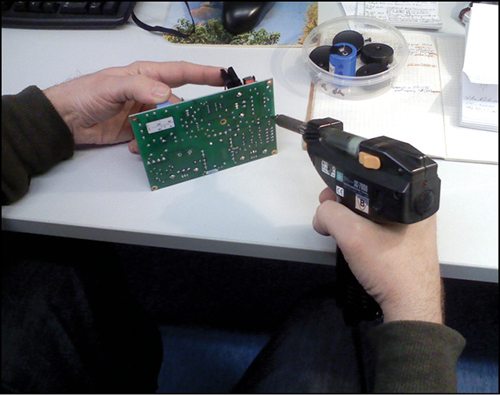De-soldering is required when any electronic component needs to be removed from a PCB, usually because it is faulty. Ideally, the aim is to remove all the solder from a component and detach the component from the PCB without damaging the de-soldered component, the neighbouring components or the PCB itself, either due to excessive heat or rough handling. There are also improperly-made soldered joints that are called dry joints, which are electrically noisy, unreliable and likely to get worse, in time. They may work well initially but can cause equipment failure at any time in the future. There will then come a time when you need to remove the solder from such a joint. Given below is the de-soldering equipments present in the market.

You can get a number of de-soldering equipments guides on the Internet teaching old-school methods such as using a solder braid, a manual de-soldering pump, or the impact method to remove components from the PCB board. But these methods are really tedious and unproductive. The results only depend on your experience, and there is a high chance that you may damage the board beyond repair.

Over the years, these methods have served their purpose very well. They have been in use for a long time and are very cost-effective, especially the use of solder braid, which is a ribbon of extremely fine copper strands woven together. It is usually supplied in small reels and comes in a variety of widths. The braid is pressed against a molten soldered joint, and capillary action draws the solder out of the joint and into the braid. The portion of the braid that contains solder is then cut off the reel and discarded. The solder braid is usually treated with a flux, so that the solder is drawn up more effectively. But as the technology is changing and electronic components are shrinking in size, these methods have become less effective.
The prices of professional de-soldering equipments have also come down over the past few years, which gives us every reason to buy one and save ourselves from all those losses that may occur with the tedious methods mentioned above.
Types of de-soldering stations
There is a wide variety of de-soldering equipments available in the market, and each type is designed to cater to specific needs. Manufacturers offer different models in each category with various features and specifications, so selecting what’s best for you can get confusing. You can address this issue in two stages—first decide on the type of de-soldering station you need and then pick a model from the selected category.
De-soldering stations can be divided into different types:
1. The first type is for de-soldering through-hole components and is called suction type de-soldering station.
2. For SMD (surface mount devices) components, you need different de-soldering equipments known as the hot-air rework systems.
3. Another tool called the heated tweezer has a more targeted approach, just as its name suggests.
4. The above tools cannot de-solder BGA (ball grid array) components. BGA packages need BGA de-soldering station specifically designed for the purpose.
Suction type de-soldering stations
Suction type de-soldering stations are used primarily to de-solder through-hole components or to remove solder from the pads after the SMD component is removed with the help of SMD de-soldering equipments. These de-soldering stations are based on the principle of suction of the melted solder from the PCB with the help of vacuum. Its heated nozzle is put over a joint with the pin at the centre to melt the solder and, once it has melted, a button is pressed to initiate the suction of the melted solder.
There is a huge variety of such de-soldering stations available in the market, but they mainly fall into two categories:
1. Integrated de-soldering units
2. Vacuum pump type de-soldering stations

Integrated de-soldering units. These are equipped with a nozzle, built-in heating element and suction unit, and most of them run directly from the mains. Such units are comparatively cheaper than a complete station but lack various features. Most of them do not even have the temperature-control function. So the tip can go up to very high temperatures while in the stand. and when you try to de-solder the joint you might even take out the pad—permanently damaging the board. Fig. 2 shows an integrated type de-soldering unit.
Vacuum-pump type de-soldering stations. These also work on the same principle as that of integrated units, but the power and suction is delivered through a different unit and is not integrated in the hand piece. Such stations come with better features like a digital display to ensure easy and reliable temperature control, power saving, auto shut-off and excellent thermal recovery. Such a unit can make your rework efficient and safe. Fig. 3 shows a vacuum pump type de-soldering station.






